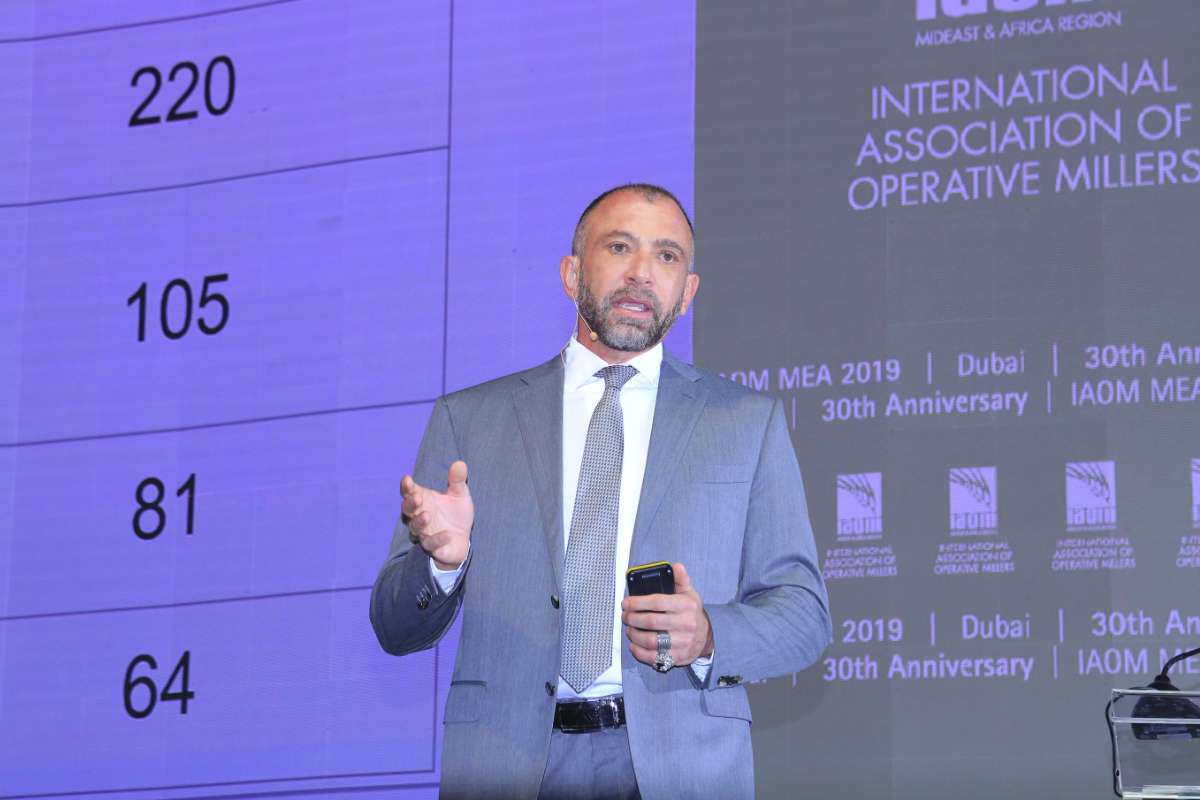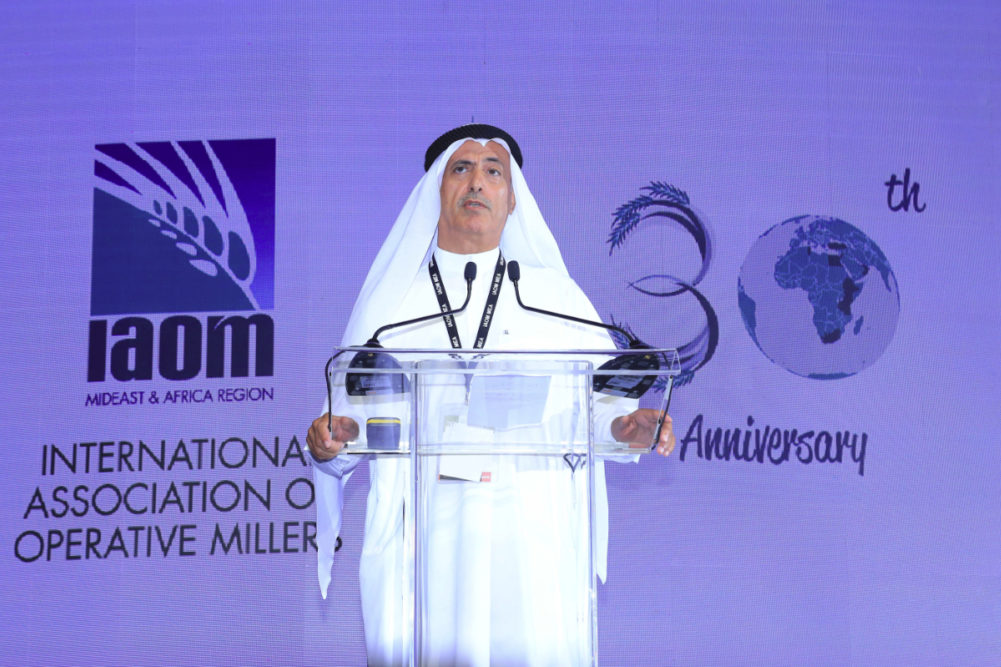The International Association of Operative Millers’ (IAOM) 30th annual Mideast and Africa (MEA) Conference and Expo was a chance to celebrate an industry grouping that has grown from small beginnings to become a major voice for milling in the region.
Conference Chairman Essa Al-Ghurair, chairman of United Arab Emirates-based Essa Al-Ghurair Investment, opened the meeting, held Nov. 3-6 at the Dubai World Trade Center, with a reminder that the MEA district has come a long way since its first meeting 30 years ago.
“Here we are after 30 years, from a humble less than 50 (delegates), I think we are now reaching over 800,” Al-Ghurair said.
He stressed the need for millers to embrace new technology.
“We should always look forward as millers,” he said.
On Dubai’s suitability as a location, he reminded delegates that the United Arab Emirates has named 2019 as the Year of Tolerance.
“As a national here, we only have 1 million out of 9 million,” he said. “We have to make sure everyone is happy in this part of the world.”
Ali Habaj, IAOM MEA regional director, told the conference that his first IAOM meeting was in 1999 and included 150 delegates. This year there were 772 registrations, including 222 millers. They included 105 exhibiting companies, 81 traders and 64 milling companies.
This year, the organization held a silo management and safe grain storage course with 43 attending, including 32 millers.
However, Habai expressed concerns for the future.
“Who’s taking over? The milling industry is not a very sexy industry,” he said.
“Economic realities are changing while we are talking now,” said Hischam El-Agamy of the IMD Business School in Switzerland. “The biggest growth in population is happening in Africa. This increase in demography will be happening in the cities. A million people are living in slums. It is not fun to live in slums.
“If we do nothing, by the next five years we will have 2 million people living in slums. We are going to add 1.2 billion, but maybe 1.5 billion people to the world (by 2030).”
He also referred to climate change.
“The last four years are the hottest years since we started recording temperatures,” he said. “We are still in denial when it comes to the environment.”
One consequence would be a water crisis, which would touch everybody.
“Water will be the biggest challenge that humanity will have,” he said. “By 2031, (there will be) over 30% reduction in grains production because of water.”
Technology on display

The expo portion of the event saw some of the largest milling equipment manufacturers showcasing the latest technology.
Refik Altunal of Alapala was in the company’s booth discussing a Duratec weighing system on display.
“It’s a completely new machine,” he told World Grain, explaining that it uses no compressed air.
In the Alapala booth, Andreas Kleiner of Swisca, for whom Alapala are sales partners, explained that the new scale was “completely compressed air free. It’s all electric driven.”
Pietro Barbalarga, commercial director of Omas, told World Grain that the company was showing the Leonardo, “the only roller mill in the world that is recovering energy,” with an alternator that returns 25% to 30% of the power. Omas believes the ability to change the speed of individual rolls will revolutionize the industry by increasing flexibility.
David Balaguer, sales director of Balaguer Rolls, explained to World Grain that the company has been in business for over 100 years, covering three generations of the same family. Primarily specialized in rolls for the food industry, it also produces sand blasting machines and measuring devices.
Bühler innovations on display included the Mercury MES system, which Gernot Ruppert, the company’s product manager, described.
“It’s a manufacturing execution system,” he said. “The new element is that the system is web based and can be accessed on a large range of devices. People save a lot of time.”
If there’s an issue, “they don’t have to run to the control room. It can integrate with any kind of technology that is web based,” he said.
One aspect of the system is that it offers greater traceability.
“Food safety is more and more important,” he said. “The customers of our customers demand more audits.”
The system makes it possible to provide the information required in the event of recall. It is also easy to use.
“The whole system is set up like an online shop,” he said.
Peter Striegl, head of business development at Bühler, gave details of the company’s new bran finisher.
“It’s a new design,” he said, explaining that the latest machine had been designed to achieve higher levels of hygiene.
Bühler also showed a color sorter. Striegl said there are now are many different kinds of camera technology available. For example, the machine in the expo booth had been designed to look at pulses.
“It can really look at real colors,” he said. “This is about to enter the wheat industry. We are testing what kind of advantages it gives.”
Also on display in the Bühler booth was a model of AlPesa, a turnkey production plant to produce atta flour for Indian flat bread. Relatively small, it has the capacity of 700 kilograms an hour, Striegl explained.
“But it’s a stand-alone system,” he said. “You could install it in our roundup. It is entry-level for those guys who want to start a small business.”
Wheat market discussions

In a session on the market, Dan Basse, president and founder of AgResource, noted that “wheat prices have been rising sharply since the first days of September” as maybe “a few people got short in Russia. Everybody has a high-quality wheat crop.”
Indrek Aigro, broker for grains at Copenhagen Merchants in Estonia, examined the situation in the Baltic Sea region.
“We had a really good early sowing season,” he said of the first stages of development of the 2019 crop. “The entry for crops into last winter was nearly perfect. We had practically no winterkill. In April, low precipitation was very good for spring sowing.”
Then there were two heatwaves in June and July.
“The July one was especially tough,” he said.
However, because the crop was in good condition, it resisted well.
“We believe 1 to 1 ½ tonnes a hectare was lost,” he said. “That’s what separated us from a record. We harvested the fourth best crop in the Baltic countries combined.”
It left a 13-million-tonne surplus for export. Even Germany, where wheat production has been falling, improved. The country now had “the main basket of export wheat in the Baltic,” he said. “The rest has been exported.”
The Baltic States already have exported 70% of their production.
“We started earlier than ever before,” he said, noting that Lithuanian wheat is now acceptable for China, the country having signed a phytosanitary protocol in September.
Poland’s harvest was almost a record and now there were around 1 million tonnes of high protein wheat left to export. Denmark, usually known for feed and biscuit wheat, has eased controls on nitrate fertilizers, improving quality.
“Danish protein content is slowly being increased,” he said.
Aigro compared the Baltic Sea region’s export prospects to the Black Sea. There was a “big shift in dynamics,” he said. “The Russian farmer is not selling.”
Drought in Kazakhstan meant that country was not exporting grain, either. Russian exports were going to South Central Asia, offering an opportunity to Baltic sellers.
“The Baltic is now shipping to traditional Black Sea destinations,” he said, giving Sudan as an example. “We still have Saudi demand to cover. We believe we are going to see a correlation between Black Sea and Baltic Sea continuing. We have had just as good a start as we had last year.”
Swiss-based Ameropa trader Sebastien Thilmany looked at the situation in the Black Sea region. With a crop of around 113 million tonnes, the exportable surplus would be 60 million tonnes. Russia had a 76-million-tonne crop, leaving 34 million for export.
“Domestic consumption in Russia keeps on growing,” he said.
Ukraine, meanwhile, has a bumper crop of almost 30 million tonnes.
“By the end of September, out of the Black Sea, we were at a record,” he said of the pace of exports. “The dynamic in the Black Sea is changing. Farmers are well informed about the market and strong financially.
For the next crop, he predicted record plantings in Russia and Ukraine, because of higher prices.




